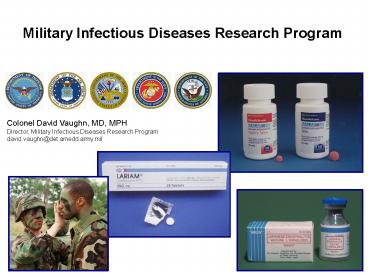Military Infectious Diseases Research Program - PowerPoint PPT Presentation
1 / 11
Title: Military Infectious Diseases Research Program
1
Military Infectious Diseases Research Program
Colonel David Vaughn, MD, MPH Director, Military
Infectious Diseases Research Program david.vaughn_at_
det.amedd.army.mil
2
MIDRP MISSION
To conduct for the Department of Defense, a
focused and responsive world class infectious
diseases research and development program
leading to fielding of effective, improved means
of protection and treatment to maintain maximal
global operational capability with minimal
morbidity and mortality
3
Military Infectious Diseases Research Programs
(all of DoD)
- Military Infectious Diseases Research Program
(MIDRP 60M in FY04) - U.S. Army Medical Materiel Development Activity
(USAMMDA 10M) - Congressionally Mandated Programs (30M to MIDRP
efforts) - SBIR/STTR (3M)
- Outside funding (NIH, NGOs, Industry)
- Other DoD funded programs that leverage the MIDRP
- Global Emerging Infections Surveillance and
Response System (GEIS 9M) - DoD HIV/AIDS Prevention Program (Life 10M)
- Biological Weapons Defense Program (DTRA 99M)
- Defense Advanced Research Projects Agency (DARPA
2.7B 133M for BW)
Naval Health Research Center
Walter Reed Army Institute of Research
Kisumu Field Site, Kenya
4
MIDRP Places
MIDRP Website
USAMRIID, Fort Detrick
NAMRU-3, Cairo
WRAIR/NMRC, Silver Spring
AFRIMS, Bangkok
NMRC-D, Lima
USAMRU-K, Nairobi
NAMRU-2, Jakarta
5
MIDRP Research Coordinators
Q
F
C
D
T
U
H
H
P
- Coordinating the work of approximately 330 Army,
Navy, Air Force, DoD civilian and contract
scientists located in 8 infectious diseases
research laboratories - Approximately 800 support personnel
6
Other Assets
Pilot Vaccine Production Facility
Accredited Lab Animal Facilities
Biosafety Level 4 Containment
Clinical Trials Units
7
Military Infectious Diseases Research
ProgramLicensed Products
- Influenza (1942)
- Adenovirus 4 7 (1980)
- Meningococcus (A, C, Y, W-135)
- Oral Live Typhoid Ty21A (1990)
- Japanese Encephalitis (1992)
- Hepatitis A (1995)
- Primaquine
- Chloroquine-Primaquine Tablets
- Sulfadoxine-Pyrimethamine (Fansidar)
- Mefloquine (Lariam )
- Halofantrine (Halfan)
- Doxycycline (Vibramycin)
- Atovaquone/Proguanil (Malarone)
- Scrub typhus diagnostic
- DEET-based Standard Insect Repellent
- Camouflage face paint-insect repellent
Licensed Vaccines
Licensed Drugs
Diagnostics And Protectants
8
What MIDRP is Doing About Antimicrobial Resistance
- Limited collection and characterization of
resistant strains of malaria and diarrhea
pathogens largely supported by the GEIS program - Vigorous program to bring new antimalarial drugs
and vaccines to market in partnership with
non-governmental organization (NGOs) and industry - Combat Casualty Care Research is working on
antimicrobial peptides and other topical options
to reduce wound infections
Kathmandu, Nepal
9
Issues Related to Antimicrobial Development
- The primary goal of MIDRP research is to prevent
rather than to treat disease. Diagnosis and
treatment are important secondary goals. - DoD is not making new antimicrobials for
bacterial pathogens, and pharmaceutical companies
have slowed development. - DoD has in place the people, infrastructure, and
successful track record for antimicrobial drug
development (the malaria drug program). - How does the problem of microbial resistance to
antibiotics compare to the problems of malaria,
dengue, diarrhea, the need for improved
diagnostics, etc? - The MIDRP is modestly resourced (40M) with a
broad research portfolio (11 program areas). - Drug development costs are large.
10
What Might MIDRP Offer?
- Continue to partner with GEIS to document
developing resistance within current research
areas such as malaria, diarrhea, and scrub
typhus. - Possible new efforts
- Explore mechanisms of resistance to include
bacterial physiology, functional genomics and
proteomics - Develop resistance-specific bacterial diagnostics
- Develop vaccines for common wound pathogens
- Coordinate prospective prophylactic treatment
studies in Iraq or in other trauma settings
(complicated due to multiple variables and
location in a war zone) - Develop new antimicrobials (drugs or other
treatment approaches) - Develop immunomodulatory approaches to disease
prevention - All new efforts require new funding, additional
personnel and extensive partnerships between DoD
and other federal agencies, universities, and
industry.
11
Conclusions
- The MIDRP contributes to the defense of the
United States and to the needs of people living
in disease endemic areas and travelers to those
areas - Drugs, vaccines, diagnostics
- Better understanding of tropical diseases
- Science infrastructure improvements in developing
countries - Antimicrobial resistance presents new challenges
Jakarta, Indonesia
Cobra Gold Exercise in Thailand
Kisumu, Kenya







![Basic Concepts in Public Health and Tropical Medicine [Public Health & Infectious Diseases 101] (mainly in relationship to parasitic diseases) PowerPoint PPT Presentation](https://s3.amazonaws.com/images.powershow.com/4061901.th0.jpg?_=201307160511)

![Basic Concepts in Public Health and Tropical Medicine [Infectious Diseases and Public Health 101] (mainly in relationship to parasitic diseases) PowerPoint PPT Presentation](https://s3.amazonaws.com/images.powershow.com/3881380.th0.jpg?_=201301071211)





















